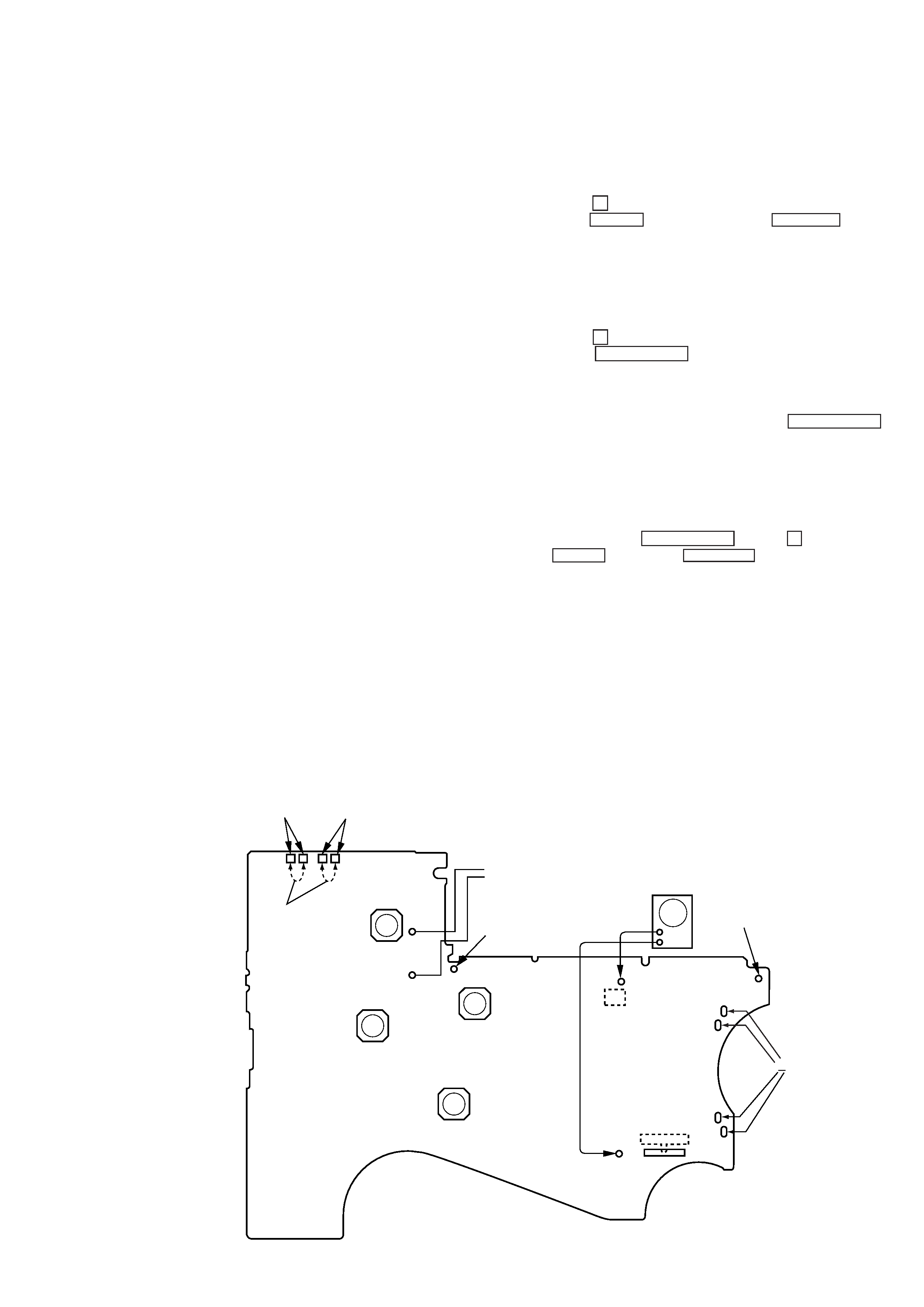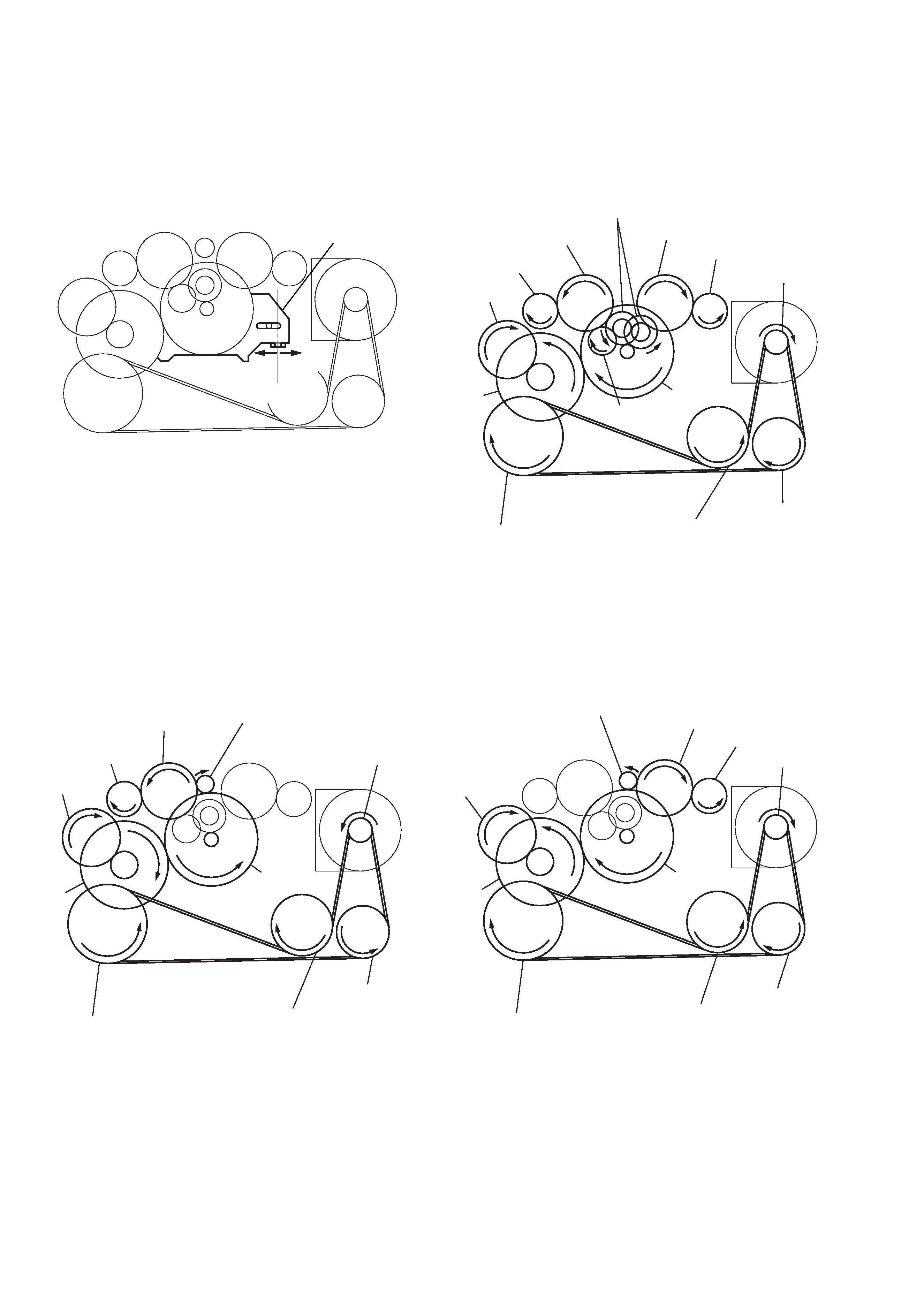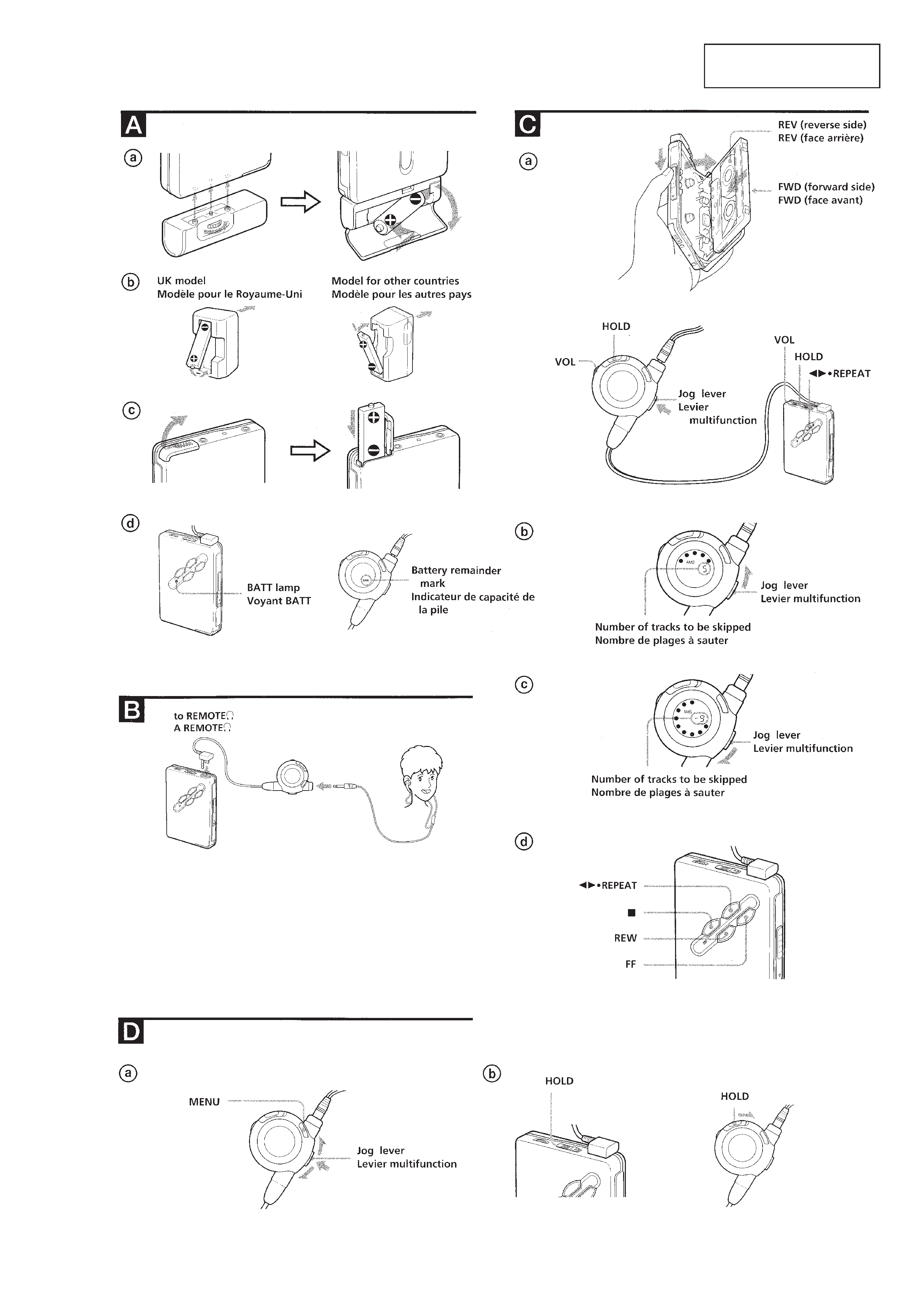
WM-EX678
AEP Model
UK Model
SERVICE MANUAL
CASSETTE PLAYER
MICROFILM
Manufactured under license from Dolby Laboratories
Licensing Corporation.
"DOLBY" and the double-D symbol
aare trademarks
of Dolby Laboratories Licensing Corporation.
SPECIFICATIONS
Model Name Using Similar Mechanism
NEW
Tape Transport Mechanism Type
MT-WMEX672-162
Tape section
Frequency response
(Dolby NR off)
Playback : 30 18,000 Hz
Output
Headphones (REMOTE
2 jack)
Load impedance 8 300
General
Power requirements
1.5 V
One rechargeable battery or one R6 (size AA)
battery
Dimensions (w/h/d)
Approx. 77.7
× 109.1 × 21.4 mm
(31/8
× 43/
8
× 27/
32
inches), incl.
projecting parts and controls
Mass
Approx. 140 g (5.0 oz.)
Approx. 205 g (7.3 oz)
(incl. rechargeable battery and cassette)
Supplied accessories
Battery case (1)
Stereo earphones with remote control (1)
Battery charger (1)
Rechargeable battery
(NC-6WM, 1.2 V, 600 mAh, Ni-Cd) (1)
Rechageable battery carrying case (1)
Carrying pouch (1)
Design and specification subject to change without notice.
Ver 1.2 1999. 05

-- 2 --
TABLE OF CONTENTS
Notes on chip component replacement
· Never reuse a disconnected chip component.
· Notice that the minus side of a tantalum capacitor may be
damaged by heat.
Flexible Circuit Board Repairing
· Keep the temperature of soldering iron around 270°C
during repairing.
· Do not touch the soldering iron on the same conductor of the
circuit board (within 3 times).
· Be careful not to apply force on the conductor when soldering
or unsoldering.
SAFETY-RELATED COMPONENT WARNING!!
COMPONENTS IDENTIFIED BY MARK
! OR DOTTED LINE WITH
MARK
! ON THE SCHEMATIC DIAGRAMS AND IN THE PARTS
LIST ARE CRITICAL TO SAFE OPERATION. REPLACE THESE
COMPONENTS WITH SONY PARTS WHOSE PART NUMBERS
APPEAR AS SHOWN IN THIS MANUAL OR IN SUPPLEMENTS
PUBLISHED BY SONY.
1. SERVICE NOTE ······························································· 3
2. GENERAL ·········································································· 5
3. DISASSEMBLY
3-1. CASE BLOCK ASSEMBLY ·········································· 7
3-2. MAIN BOARD ······························································· 8
3-3. BELT (F2) ······································································· 8
3-4. MOTOR (F2) (M901) ····················································· 9
3-5. CASSETTE LID ASSEMBLY ······································· 9
3-6. REEL ORNAMENT ASSEMBLY ······························· 10
3-7. HOLDER ASSEMBLY ················································ 10
3-8. PINCH LEVER (N)/(R) ASSEMBLY ·························· 11
3-9. MAGNETIC HEAD (HP901) ······································· 11
4. MECHANICAL ADJUSTMENT ································ 12
5. ELECTRICAL ADJUSTMENT ·································· 12
6. DIAGRAMS
6-1. BLOCK DIAGRAM ····················································· 13
6-2. IC BLOCK DIAGRAMS ·············································· 15
6-3. PRINTED WIRING BOARD ······································· 16
6-4. SCHEMATAC DIAGRAM ··········································· 19
6-5. IC PIN FUNCTION ······················································ 22
7. EXPLODED VIEWS
7-1. CABINET BLOCK, MAIN BOARD ··························· 24
7-2. MECHANISM DECK BLOCK ···································· 25
8. ELECTRICAL PARTS LIST ······································· 26

-- 3 --
SECTION 1
SERVISE NOTE
[Service Mode]
The service mode enables to operate the mechanism of WM-EX678
while the MAIN board is opened.
Rotation of the idler gear (A) (S side) is detected using the photo-
reflector (PH701) in the WM-EX678. PH701 is located on the
MAIN board, therefore the rotation of the idler gear (A) (S side)
cannot be detected by PH701 when the MAIN board is removed.
As a result, the motor cannot be controlled and cannot run correctly.
To repair the machine after the MAIN board is removed while the
main power is turned on, follow the procedures as described below.
1. Setting
1)
Remove the cabinets referring to section "3. DISASSEMBLY".
Open the MAIN board.
2)
Connect the motor (M901) and the plunger solenoid (PM901)
to the MAIN board using the jumper wires. When the extension
jig (1-769-143-11) (10 wires as a set) is used, they can be
connected easily.
3)
Short the TAPE DETECT switch (S901-1) and the ATS switch
(S901-2).
4)
Connect an AF oscillator to TP53 (P. IN) and TP14 (GND).
5)
Connect DC 1.3 V from external regulated power supply to
`
and
' terminals of the battery.
2. PRE-SET status
The PLAY, FF and REW modes can be entered only from the PRE-
SET status.
1)
Check that the slider (NR) is in the center position (S701), and
the FWD/REV switch is also in the center position. When
these switches are not in the center position, set them to the
PRE-SET status as follows.
2)
Move the FWD/REV switch (S701) to the same position as the
slider (NR) is set.
3)
The slider (NR) can be moved when the main power of the
regulated power supply is turned OFF once then back ON.
Move the FWD/REV switch (S701) to the center position in
synchronism with the timing when the slider (NR) is moved.
3. FF, REW modes
1)
Check that the PRE-SET status is set.
2)
Connect square wave or sine wave to TP53 (P. IN) and TP14
(GND). (See illustration below.)
3)
Press the
p switch (S702) to enter the STOP mode.
4)
Press the FF AMS switch (S704) and the REW AMS switch
(S705).
4. PLAY mode
1)
Check that the PRE-SET status is set.
2)
Connect square wave or sine wave to TP53 (P. IN) and TP14
(GND). (See illustration below.)
3)
Press the
p switch (S702) to enter the stop mode.
4)
When the
9(REPEAT switch (S703) of the MAIN board
is pressed, the slider (N/R) moves once to the F side then moves
to the R side. When the FWD/REV switch (S701) is pressed
in the synchronism with the above timing, the machine can
enter the PLAY (R side) mode. Press the
9(REPEAT
switch (S703) again, and move the FWD/REV switch (S701)
in the synchronism with the motion of slider (NR). It enables
the machine to enter into the PLAY (F side) mode.
Note 1: When you fail to enter the PLAY mode, re-start from step
1) PRE-SET status.
Note 2: Regarding the
9(REPEAT (S703), p (S702),
FF AMS (S704), and REW AMS (S705) switches, use
these switches of the remote control unit as much as possible.
Note 3: If a headphones are used, the beep sound shows the timing
of the FWD/REV switch (S701).
TAPE DETECT
SWITCH
(S901-1)
ATS
SWITCH
(S901-2)
Short
Plunger (PM901)
AF OSC
Battery terminal
'
Battery terminal
`
TP14
(GND)
S701
FWD
STOPREV
oeREPEAT
(S703)
p(S702)
PH701
M901
TP53 (P.IN)
REW AMS
(S705)
FF AMS
(S704)
M
+
Square-wave (sine wave)
10 Hz, -3.5 dB
MAIN BOARD (SIDE B) --

-- 4 --
[ Slider (NR) ]
[ Tape drive mechanism ]
Tape drive mechanism in PLAY mode
Tape drive mechanism in FF mode
Tape drive mechanism in REW mode
Slider (NR)
Center
F side R side
Insert Flywheel (N)
Pulley (Reverse)
Clutch Assy
Motor Pulley
Gear (REEL)(S side)
Gear
(REEL)(T side)
Gear (NR)
(FWD : Left side
REV : Right side)
Idler Gear
Idler Gear (A)(S side)
Idler Gear
(A)(T side)
Insert Flywheel (R)
Cam Gear
Gear (Y)
Insert Flywheel (N)
Pulley (Reverse)
Clutch Assy
Motor Pulley
Gear
(REEL)(T side)
Idler Gear
(A)(T side)
Insert Flywheel (R)
Cam Gear
Gear (Y)
Gear (FR)
(FF : Left side)
Insert Flywheel (N)
Pulley (Reverse)
Clutch Assy
Motor Pulley
Gear
(REEL)(S side)
Idler Gear
(A)(S side)
Insert Flywheel (R)
Cam Gear
Gear (Y)
Gear (FR)
(REW : Right side)

-- 5 --
SECTION 2
GENERAL
This section is extracted
from instruction manual.
